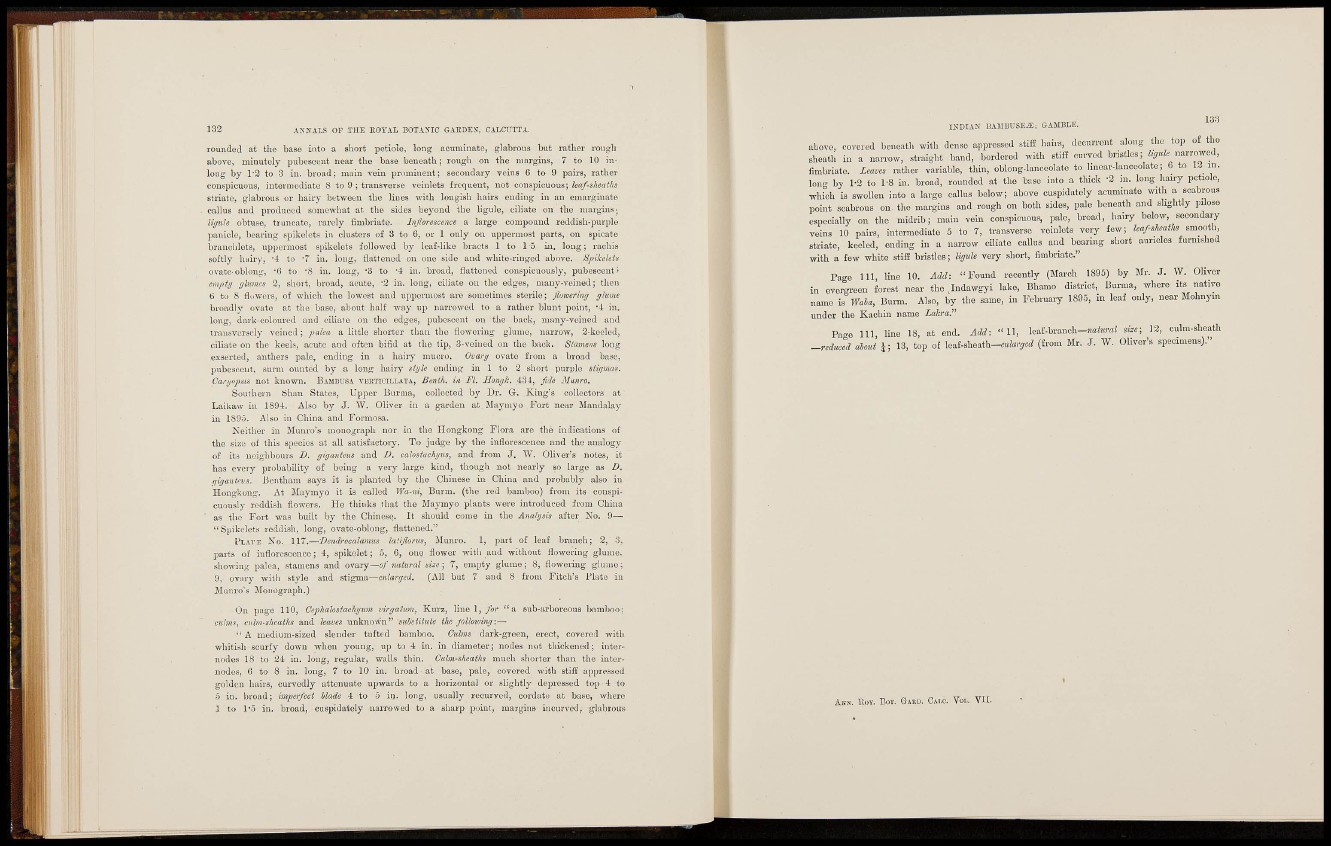
132 A^'^•ALS OF THE EOT AL BOTANIC GARDEN, CALCUTTA.
rounded at the base into a short petiole, long acuminatc, glnbrous bat i-ather rough
above, minutely pubescent near the base beneath; rough on the margins, 7 to 10 inloug
by r 2 to 3 in. broad; main vein prominent; secondary veins 6 to 9 paira, rather
conspicuous, jiitormediate 8 to 9 ; transverse veinlets frequent, not conspicuous;
striate, glabrous or hairy between the Hues with longish hairs ending in an emarginate
callus and produced somewhat at the sides beyond the ligule, oiliate ou the margins;
ligule obtuse, truncatc, rarely fimbriate. Inflorcsccnce a large compound reddish-purple
panicle, bearing spikelets in clusters of 3 to 6, or 1 only on uppermost parts, on spicate
branclilets, uppermost spikelets followed by leaf-like bracts 1 to 1 5 in. long; rachis
softly huiry, -l to -7 in. long, flattened on one side and white-ringed above. Spikelets
ovate-oblong, -6 to '8 in. long, to '-i in. broad, flattened conspicuously, pubescent i
enifit// glumes 2, short, broad, acute, '3 in. long, ciliate on the edges, many-veined; then
« to 8 flowers, of which the lowest and iippermost are somelimes sterile; Jloioering glume
broadly ovate at the base, about half way up narrowed to a rather bluut point, in.
long, dark-coloured and ciliale on the edges, pubescent on the back, many-veiued and
traiibversely veined; paleo, a little shorter tliaii tbe flowering glume, narrow, 2-keeled,
ciliate on the keels, acute and often bifid at the tip, 3-veined on the back. Stamens long
exserted, anthers pale, ending in a liaiiy mucro. Ovar// ovate from a broad base,
pubescenc, surm ounted by a long hairy style ending in 1 to 2 short purple stigmas.
Carynpsis not known, Bambusa v e k t i c i l l a t a , Benth. i/i Fl. liongk. 434, fide Manro.
Southern iShan States, Upper Burma, collected by Dr. G. King's collectors at
Laikaw in 189-1. Also by J. W. Oliver in a garden at Maymyo Fort near Mandalay
in 1895. Also in China and Formosa.
Neither in Munro's monograph nor ia the Hongkong Flora are the indications of
t h e size of this species at all satisfactory. To judge by the inflorescence and the analogy
of its neighbours D. giganteus and D. calostachyus, and from J. W. OHver's notes, it
has every probability of being a very large kind, though not nearly so large as D.
giganteus. Bcntham says it is planted by the Chinese in China and probably also in
Hongkong. At JIaymyo it is called Wa-ni, Barm, (the red bamboo) from its conspicuously
reddish flowers. He thinks ihat the Maymyo plants were introduced from China
as the Fort was built by the Chinese. It should come in the Analysis after No. 9—
" Spikelets reddish, long, ovate-oblong, flattened."
[•"LArE No. 117.—'Dendrocalamus latifiorus, JIunro. 1, part of leaf branch; 2, 3,
parts of inflorescence; 4, spikelet; 5, 6, one flower with and without flowering glume,
showing palea, stamens and ovuij—of natural sise] 7, empty glume; 8, flowering glume;
9, ovary with style and stigma—enlarged. (All but 7 and 8 from Fitch's Plate in
J l a n r o ' s Monograph.)
On page 110, Cephalostachjum vivgatum, Kin'z, line 1 , / o r " a eub-arboreous bamboo;
cuhn^, cnlm-skeaths and leaves unknovVn" 'suhstitute the plhiuing\—
" A medium-sized slender tuftc-d bamboo. Culms dark-green, erect, covcrod with
whitish scurfy down when young, up to 4 in. in diameter; nodes not tliickened; internodes
18 to 24 in. long, regular, walls thin. Calm-sheaths much shorter than the intcrnodes,
6 to 8 in. long, 7 to 10 in. broad at base, pale, covcred with stiii appresscd
golden hairs, curvedly attenuate upwards to a horizontal or slightly depressed top 4 to
5 in. broad; imperfect hladc 4 to 5 in. long, usually recurved, cordate at base, where
1 to I'D in. broad, cuspidately narrowed to a sharp point, margins incurved, glabrous
INDIAN BAMEUSE^E; GAMBLE.
above, coYCrcd beneath with dense appressed . t i S hairs, dccurrent along the top of tho
sheath in a narrow, straight band, bordered with stiff curvcd bristles; hgnle narrowed,
fimbriate. Leaves rather variable, thin, oblong-lanceolate to Hneav-lanceolate; 6 t o U in.
long by 1-2 to 1-8 in. broad, rounded at tho base into a thick -2 in. long h a n y petiole,
which is swollen into a large callus below; above cuspidately acuminate with a scabrous
point scabrous on. tho margins and rough on both sides, pale beneath and slightly piloso
especially on the midrib; main vein conspicuous, pale, broad, hairy below, secondary
veins 10 pairs, intermediate 5 to 7, transverse veinlets very few; kaf-sheatlis smooth,
striate , keeled, ending in a narrow ciliate callus and bearing short auricles furnished
with a few white s t iS bristles ; ligule very short, fimbriate."
Patre 111, line 10. Add: "Found recently (March 1895) by Mr. J . W. Oliver
in o v e r s e e n forest near the J n d a w g y i lako, Bhamo district, Burma, where its native
name is Wala, Burm. Also, by the same, in Februaiy 1895, in leaf only, near Mohnyin
under the Kachin name LahraJ'
Page 111 lino 18, at end. Add-. " 1 1 , Icaf-branch-Haiwrai size- 12, culm-sheath
alout J ; 13, top o£ loaf-sheath-^«/«/-^^-; (from Mr. J . W. OUvor's specimens}."
Akn. Pvoy. Bor. Oaru. Cat,c. Vol. VII.